
Monte Alto is an archaeological site on the Pacific Coast in what is now Guatemala.

Monte Alto is an archaeological site on the Pacific Coast in what is now Guatemala.
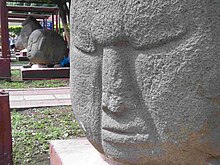
Located 20 km southeast from Santa Lucía Cotzumalguapa in Escuintla, Monte Alto was occupied as early as 1800 BC, but has a fairly light presence – less than either El Bálsamo or Los Cerritos Sur located about 10 km west and east of Monte Alto respectively. During the Late Preclassic (400 BC to AD 200), Monte Alto became a regional center.
The site has 45 major structures, the tallest being a 20 m high pyramid. The Monte Alto Culture is one of the oldest in Mesoamerica and perhaps predates the Olmec.
There is also a substantial Early Classic occupation but it is largely localized at Structure 6, a large platform located well to the northeast. [1]
Although Monte Alto is noted for its sculptures (heads and potbellies), more than a dozen tabular shaped stone stelae were found as well as three stone altars.
Two general styles of sculpture are found at the Monte Alto site, one representing a human head, and the other, a human body. Since both the heads and the bodies are rather crudely shaped from large, rounded basaltic boulders, the subjects have a decidedly corpulent appearance. Because they seem to be male figures, they have been termed "potbellies" in the archaeological literature.
Fifteen plain stelas were recorded at Monte Alto and one alignment of three large plain stelae erected in a north–south line could have served astronomical purposes as a means for recording days and the position of the sun for agricultural purposes. In fact, the azimuth from the principal pyramid to the south stela marked the winter solstice on December 21. The sun rose over the central stela on February 19: February 19 at midnight marked the eastern elongation of the Eta Draconis star in the Pleiades during the Late Preclassic period.
According to Marion Popenoe de Hatch, Eta Draconis shows unusual stability, and, that from 1800 B.C. to A.D. 500, the annual date of its meridian midnight transit varied less than one day. [2] She has shown that alignments of certain monuments at Takalik Abaj, also mark the eastern elongation of Eta Draconis at various periods during Tak'alik Abaj existence. [3]
Many of the Monte Alto sculptures are magnetic as well. Since certain distinctive patterns of magnetism recur with some frequency, it would appear that the sculptures were executed by artisans who were aware of these properties. If this is true, the Monte Alto sculptures no doubt deserve recognition as the oldest known magnetic artifacts in the world. [4]
Of the collection of "potbellies" sculptures from Monte Alto on display in the town park of La Democracia, Guatemala and in front of its local museum, Museo Regional de Arqueología de la Democracia, four of the heads and three of the bodies were found to have magnetic properties. All four of the heads have a north magnetic pole located in their right temples, while three of them have south magnetic poles below the right ear and the fourth (that in front of the museum) has a south magnetic pole in its left temple. Such a pattern of occurrence is unlikely to be a matter of chance, even in a sample size as small as four.
During the Maya Preclassic period, the sites in the area that are contemporary to Monte Alto are Chiapa de Corzo (Mesoamerican site), Izapa, Abaj Takalik, and El Baul, along with such highland communities as Kaminaljuyu and Chalchuapa. [5]

Kaminaljuyu is a Pre-Columbian site of the Maya civilization located in Guatemala City. Primarily occupied from 1500 BC to 1200 AD, it has been described as one of the greatest archaeological sites in the New World—although the extant remains are distinctly unimpressive. Debate continues about its size, integration, and role in the surrounding Valley of Guatemala and the Southern Maya area.

Mesoamerican chronology divides the history of prehispanic Mesoamerica into several periods: the Paleo-Indian ; the Archaic, the Preclassic or Formative (2500 BCE – 250 CE), the Classic (250–900 CE), and the Postclassic (900–1521 CE); as well as the post European contact Colonial Period (1521–1821), and Postcolonial, or the period after independence from Spain (1821–present).

Tak'alik Ab'aj is a pre-Columbian archaeological site in Guatemala. It was formerly known as Abaj Takalik; its ancient name may have been Kooja. It is one of several Mesoamerican sites with both Olmec and Maya features. The site flourished in the Preclassic and Classic periods, from the 9th century BC through to at least the 10th century AD, and was an important centre of commerce, trading with Kaminaljuyu and Chocolá. Investigations have revealed that it is one of the largest sites with sculptured monuments on the Pacific coastal plain. Olmec-style sculptures include a possible colossal head, petroglyphs and others. The site has one of the greatest concentrations of Olmec-style sculpture outside of the Gulf of Mexico, and was made a World Heritage Site in 2023 because of its long history of occupation.
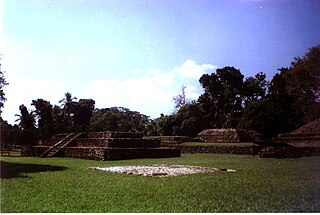
Izapa is a very large pre-Columbian archaeological site located in the Mexican state of Chiapas; it is best known for its occupation during the Late Formative period. The site is situated on the Izapa River, a tributary of the Suchiate River, near the base of the volcano Tacaná, the sixth tallest mountain in Mexico.

La Mojarra Stela 1 is a Mesoamerican carved monument (stela) dating from 156 CE. It was discovered in 1986, pulled from the Acula River near La Mojarra, Veracruz, Mexico, not far from the Tres Zapotes archaeological site. The 4+1⁄2-foot-wide (1.4 m) by 6+1⁄2-foot-high (2.0 m), four-ton limestone slab contains about 535 glyphs of the Isthmian script. One of Mesoamerica's earliest known written records, this Epi-Olmec culture monument not only recorded this ruler's achievements, but placed them within a cosmological framework of calendars and astronomical events.

Cotzumalhuapa archaeological culture is from the piedmont area of the Escuintla Department, Guatemala. The Cotzumalhuapa archaeological zone is near the town of Santa Lucía Cotzumalguapa.
Tres Islas is a small pre-Columbian Maya archaeological site 20 kilometres (12 mi) north of Cancuen in Petén Department, northern Guatemala. The site has been dated to the Late Preclassic and Late Classic periods of Mesoamerican chronology. The main feature of the site is a group of three Maya stelae and an altar, arranged in a way that mimics an E-Group Maya astronomical complex.
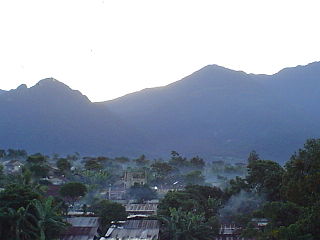
Chocolá is a Preclassic Southern Maya site whose developmental emphasis was from c. 1000 BC to AD 200. The site lies within the Southern Maya area.

The site of Ujuxte after the Ramón or Breadnut tree ) is the largest Preclassic Maya site to be discovered on the Guatemalan Pacific coast. It is in the Retalhuleu Department, in western Guatemala.

La Blanca is a pre-Columbian Mesoamerican archaeological site in present-day La Blanca, San Marcos Department, western Guatemala. It has an occupation dating predominantly from the Middle Preclassic period of Mesoamerican chronology. This site belongs to the later period of the Mokaya culture.
The Southern Maya Area is a region of Pre-Columbian sites in Mesoamerica. It is long believed important to the rise of Maya civilization, during the period that is known as Preclassic. It lies within a broad arc going southeast from Chiapa de Corzo in Mexico to Copán and Chalchuapa, in Central America.
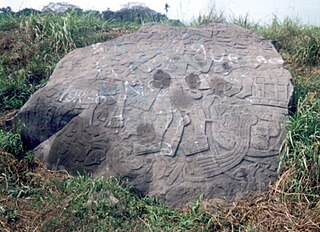
Bilbao is a Mesoamerican archaeological site about 1 mile (1.6 km) from the modern town of Santa Lucía Cotzumalguapa in the Escuintla department of Guatemala. The site lies among sugar plantations on the Pacific coastal plain and its principal phase of occupation is dated to the Classic Period. Bilbao was a major centre belonging to the Cotzumalhuapa culture with its main occupation dating to the Late Classic. Bilbao is the former name of the plantation on which the site lies and from which it has derived its name.

Potbelly sculptures are in-the-round sculptures of obese human figures carved from boulders. They are a distinctive element of the sculptural tradition in the southern Maya area of Mesoamerica. The precise purpose of potbelly sculptures is unknown, although they appear to have been the focus of public veneration and ritual directed by the ruling elite. Although this sculptural tradition is found within the southern Maya area, it has been recognized that the sculptures themselves are non-Maya.
Balberta is a major Mesoamerican archaeological site on the Pacific coastal plain of southern Guatemala, belonging to the Maya civilization. It has been dated to the Early Classic period and is the only known major site on the Guatemalan Pacific coastal plain to have exposed Early Classic architecture that has not been buried under posterior Late Classic construction. The site was related to the nearby site of San Antonio, which lies 6 kilometres (3.7 mi) to the west.
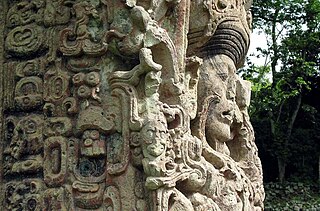
Maya stelae are monuments that were fashioned by the Maya civilization of ancient Mesoamerica. They consist of tall, sculpted stone shafts and are often associated with low circular stones referred to as altars, although their actual function is uncertain. Many stelae were sculpted in low relief, although plain monuments are found throughout the Maya region. The sculpting of these monuments spread throughout the Maya area during the Classic Period, and these pairings of sculpted stelae and circular altars are considered a hallmark of Classic Maya civilization. The earliest dated stela to have been found in situ in the Maya lowlands was recovered from the great city of Tikal in Guatemala. During the Classic Period almost every Maya kingdom in the southern lowlands raised stelae in its ceremonial centre.

Huamelulpan is an archaeological site of the Mixtec culture, located in the town of San Martín Huamelulpan at an elevation of 2,218 metres (7,277 ft), about 96 kilometres (60 mi) north-west of the city of Oaxaca, the capital of Oaxaca state.
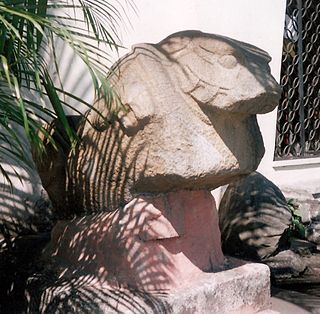
The Museo Regional de Arqueología de la Democracia is an archaeological museum in the municipality of La Democracia in the department of Escuintla in Guatemala. The museum displays pre-Columbian Mesoamerican artefacts from the Pacific lowlands datingfrom the Preclassic Period through to the Postclassic Period, with a particular emphasis upon the local Monte Alto culture. The museum is open from Tuesday through to Saturday from 8 am to 4 pm.

Ixtonton is a Maya archaeological site in the department of Petén in northern Guatemala. It is located in the northwestern portion of the Maya Mountains in the municipality of Dolores. The ruins are situated approximately 2 kilometres (1.2 mi) east of the town of Dolores itself. Ixtonton was the capital city of one of the four Maya kingdoms in the upper Mopan Valley. The site was occupied from the Late Preclassic period through to the Terminal Classic, with some evidence of continued activity into the Postclassic. For the majority of its history Ixtonton was the most important city in the upper Mopan Valley, with its only rivals emerging in the Late Classic. The acropolis at Ixtonton is laid out around two plazas on top of an artificially modified karstic hill.
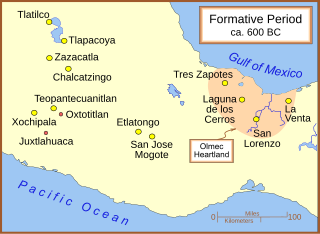
Regional communications in ancient Mesoamerica are believed to have been extensive. There were various trade routes attested since prehistoric times. In this article, especially the routes starting in the Mexico Central Plateau, and going down to the Pacific coast will be considered. These contacts then went on as far as Central America.
The history of Maya civilization is divided into three principal periods: the Preclassic, Classic and Postclassic periods; these were preceded by the Archaic Period, which saw the first settled villages and early developments in agriculture. Modern scholars regard these periods as arbitrary divisions of chronology of the Maya civilization, rather than indicative of cultural evolution or decadence. Definitions of the start and end dates of period spans can vary by as much as a century, depending on the author. The Preclassic lasted from approximately 3000 BC to approximately 250 AD; this was followed by the Classic, from 250 AD to roughly 950 AD, then by the Postclassic, from 950 AD to the middle of the 16th century. Each period is further subdivided:
Famsi: Monte Alto (UTM 722341E, 1573508N)
Parsons, Lee A. 1976 Excavation of Monte Alto, Escuintla, Guatemala In Research Reports: Abstracts and Reviews of Research during the Year 1968. pp. 325–332 National Geographic Society, Washington, DC
Popenoe De Hatch, Marion 1989 A seriation of Monte Alto sculptures In New Frontiers in the Archaeology of the Pacific Coast of Southern Mesoamerica. Frederick Bove and Lynette Heller, eds. pp. 25–42 Anthropological Research Papers, 39 Arizona State University, Tempe